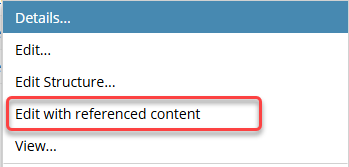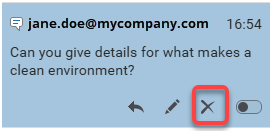Understand Oxygen behavior
You can use the Oxygen-based editor to easily create and edit structured DITA and DocBook documents in an XML data format. If you are not working in a collaborative Review, your ability to access some Oxygen features can vary based on how they are configured by an administrator.
 Oxygen features that can be configured by an administrator:
Oxygen features that can be configured by an administrator:

![]() Administrators can follow the steps in: Grant permissions to options in Oxygen
Administrators can follow the steps in: Grant permissions to options in Oxygen

 When you open a map or bookmap in Oxygen, you may see all of the referenced content expanded and editable. This can happen in two ways:
When you open a map or bookmap in Oxygen, you may see all of the referenced content expanded and editable. This can happen in two ways:
- In the Components browser, on a component you right-click or use the
 Options menu and can select Edit with referenced content.
Options menu and can select Edit with referenced content.
- In this case, you see all of the referenced content expanded and editable.
- If you select Edit... instead, the referenced content is shown only as a link and the referenced content is shown but is not editable without opening the source of the reference.
- In the Components browser, on a component you right-click or use the
 Options menu and do NOT see an option to Edit with referenced content.
Options menu and do NOT see an option to Edit with referenced content. 
- In this case, an administrator has configured Oxygen to open all components with the referenced content expanded and editable.
- Now this is the behavior you see when you select Edit...
- You do not have the option to open a component without the referenced content expanded and editable
 If the component is NOT a map or bookmap and a user opens a component with the Edit with referenced content option, referenced content appears as normal. (Cross-references appear as links and content references in a grey box where the referenced content is shown but is not editable without opening the source of the reference.)
If the component is NOT a map or bookmap and a user opens a component with the Edit with referenced content option, referenced content appears as normal. (Cross-references appear as links and content references in a grey box where the referenced content is shown but is not editable without opening the source of the reference.)


Change tracking
This is an Oxygen feature that records and displays edits made to a component, such as insertions, deletions, and formatting changes, allowing users to see the history of revisions and to accept or reject them.
By default:
- The
 Change Tracking option is not turned on in the Oxygen editor.
Change Tracking option is not turned on in the Oxygen editor. - You can make changes to text and they are NOT highlighted.
- You can turn Change Tracking on
 An administrator can force Change tracking to work in one of the following ways for specific users and roles:
An administrator can force Change tracking to work in one of the following ways for specific users and roles:
- Force Change Tracking to stay on: All changes are highlighted and Change Tracking cannot be turned off.
- Force Change tracking to stay off: No changes are highlighted, and Change Tracking cannot be turned on.



Accept and reject changes
Users can go through each proposed change and either accept it to incorporate it into the text or reject it to keep the text as it was before the change.
By default:
- All users can see and use the
 Accept and
Accept and  Reject action buttons
Reject action buttons - All users can see and use the Accept All and Reject All buttons at the bottom of the
 Review pane
Review pane
 An administrator can disable the use of these Accept and Reject options for specific users and roles.
An administrator can disable the use of these Accept and Reject options for specific users and roles.



Delete another user's comments
Oxygen provides a collaboration tool in the Review pane that attaches a comment to a specific piece of text so you can provide feedback, ask questions, or submit ideas without altering the actual content.

By default: The ![]() Remove button is NOT active in a comment when the current user editing the component did not create the comment.
Remove button is NOT active in a comment when the current user editing the component did not create the comment.
 An administrator can allow the Remove button to be active even if he current user editing the component did not create the comment.
An administrator can allow the Remove button to be active even if he current user editing the component did not create the comment.



Edit the XML source code directly
Direct source editing provides complete control over every element, attribute, and character within the XML structure. This level of precision is often necessary for complex configurations, schema adherence, or fine-tuning.
By default: Any user can select the  More... menu, and then
More... menu, and then ![]() Edit XML Source.
Edit XML Source.
 An administrator can hide the Edit XML Source option for specific users and roles.
An administrator can hide the Edit XML Source option for specific users and roles.